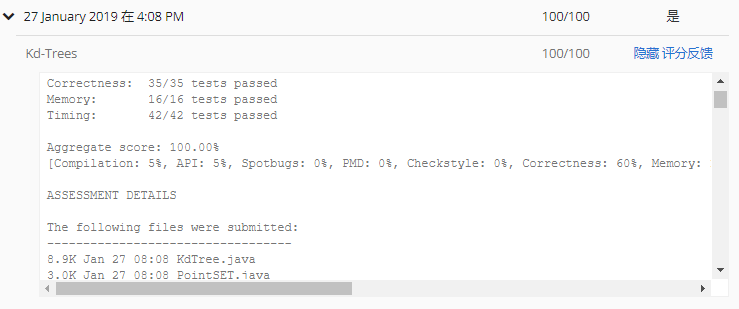Programming Assignment 5: Kd-Trees
编程作业五
我的代码:PointSET.java & KdTree.java
问题简介
是平衡树的几何应用中介绍的 2d 树,不再过多描述,要求实现范围查找和最近邻居这两个功能。
任务摘要
Brute-force implementation. Write a mutable data type PointSET.java that represents a set of points in the unit square. Implement the following API by using a red–black BST:
public class PointSET { public PointSET() // construct an empty set of points public boolean isEmpty() // is the set empty? public int size() // number of points in the set public void insert(Point2D p) // add the point to the set (if it is not already in the set) public boolean contains(Point2D p) // does the set contain point p? public void draw() // draw all points to standard draw public Iterable<Point2D> range(RectHV rect) // all points that are inside the rectangle (or on the boundary) public Point2D nearest(Point2D p) // a nearest neighbor in the set to point p; null if the set is empty public static void main(String[] args) // unit testing of the methods (optional) }2d-tree implementation. Write a mutable data type KdTree.java that uses a 2d-tree to implement the same API (but replace PointSET with KdTree). A 2d-tree is a generalization of a BST to two-dimensional keys. The idea is to build a BST with points in the nodes, using the x- and y-coordinates of the points as keys in strictly alternating sequence.
详细参见:specification。
问题分析
实现 2d 树之前,还要我们先来一个暴力算法,也就是范围查找和最近邻需要访问所有的点。作业给我们提供了二维点和矩形的数据类型:Point2D 和 RectHV,还说暴力算法必须使用 SET 或 java.util.TreeSet。因为 Point2D 里有 compareTo() 方法,所以可以直接塞到平衡树里。那插入和查找的复杂度都是对数级别,而范围查找和最近邻的性能要求是所需时间和点的数量成正比,于是遍历就好。综上,暴力算法完全没有技术含量,直接看代码 PointSET.java。
接着是正题,API 没变,实现改成 2d 树,第一步来设计节点,我的长这样:
public class KdTree {
private static final boolean VERTICAL = true;
private static final boolean HORIZONTAL = false;
private Node root; // the root of KdTree
private int size; // the number of points in the KdTree
// KdTree helper node data type
private static class Node {
private Point2D p; // the point
private Node lb; // the left/bottom subtree
private Node rt; // the right/top subtree
private boolean divide; // true->vertical, false->horizontal
public Node(Point2D p) {
this.p = p;
}
}
}
Checklist 里建议的编程步骤有给出样例,每个节点里有对应的矩形,像根节点对应 1*1 的最大矩形,但是后面又说实际上可以不用存来节省空间,所以我这个应该是后面自己思索的吧,时间太长不大记得。
方法 isEmpty() 和 size() 按道理要很简单,方法 insert() 需要注意些:
What should I do if a point has the same x-coordinate as the point in a node when inserting / searching in a 2d-tree? Go the right subtree as specified.
What should I do if a point is inserted twice in the data structure? The data structure represents a set of points, so you should keep only one copy.
摘自 Checklist 的常见问题,x 节点碰到相等的往右,那 y 节点就往上,然后二者都相等就啥也不干。模仿课程代码,借助私有的方法来递归地插入,每次改变节点的划分方向,问题不大。
contains() 方法注意相同值一样地处理,x 节点相同 x 值找右边这样就可以。接着是 draw() 方法,Checklist 里为我们提供了参数设置:
How should I set the size and color of the points and rectangles when drawing? Use StdDraw.setPenColor(StdDraw.BLACK) and StdDraw.setPenRadius(0.01) before before drawing the points; use StdDraw.setPenColor(StdDraw.RED) or StdDraw.setPenColor(StdDraw.BLUE) and StdDraw.setPenRadius() before drawing the splitting lines.
红色铅垂线和蓝色水平线直接借助矩形数据类型的 draw() 方法来画其实。
然后实现 range() 方法,当前搜索点代表的矩形可以通过一些信息就地构造出来,如果和查询矩形没有相交,那么也就没有继续搜索下去的必要。nearest() 方法需要尽快找到一个比较近的点,这样才有可能剪枝,提高效率,所以倾向于先搜索和查询点一个方向的子树,因为一般来说较近点在一个方向。另外,Checklist 最后提示的改进里提醒说,直接用距离的平方就好,平方根的消耗是可以省去的。这两直接也直接看吧:KdTree.java。
测试结果



